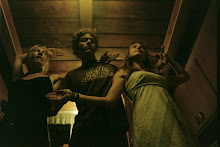
All of these things suggest that I would make a terrible sewer. At least, that's what I assumed, until I tried my hand at patching up my favorite pair of jeans. Fortunately, it seems that somewhere beneath this clumsy exterior of a likely natural-selection victim lies the steady hands and iron patience of a Navy Seals sniper that happens to be a 75-year old woman.
Ok, so I can't sew like your grandma, but I did manage to patch up my jeans (notice the finely sculpted hindquarters above). And if I can do it, pretty much anybody can. For my little project, I took a bit of denim from the inside of my back-right pocket (tip to pickpockets: I always wear my wallet on my left-side), pinned it to the hole (which I had cut out more or less neatly from the hanging tear), and sewed. When I had made stitches all around the patch, I ran a couple of small stitches over my last stitch, and tied the two ends of my string together with several slip-knots. Now, instead of seeing my beautiful green boxers, people will just think that I'm wearing black ones!
Since my powers of description are a little lacking, I've included this link to let you see how a pro does it. Or at least someone whose hands aren't malformed clubs like mine (hey, we can't all be perfect).
Jean Patching Guide



